Torch and Torch Relay
| The Actual Relay Route Programme
The overall Olympic Torch Relay programme fixed by the report of its special committee is as follows:- The Relay Implements and Apparatus Torch: |
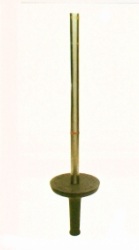
|
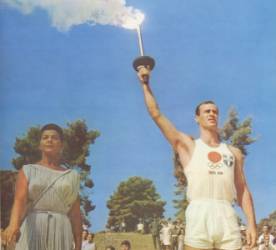 |

| Description: | Bowl is inscribed: " XVII Olympiad Tokyo 1964" and Olympic Rings. The bottom of the cylinder features the Tokyo official logo. |
|---|---|
| Material | The bowl is made of blackened aluminum alloy. The cylinder is clad with stainless steel; |
| Fuel: | Two-component ignition material; |
| Torch measure: | Lenght: 65 cm Weight: 826 gr |
| Torches total: | |
| Design by: | Prof. Maiure and his team from the Naples National Museum of Archaeology |
| Manufacturer: | |
| Date of the torch relay: | 21. Aug. - 10. Oct. 1964 |
| Duration: | 51 days |
| Numbers of runners: | Outside Japan : 870 Japan: 4,374 |
| Distance total: | 7,487 km |
| Name of the last runner: | Yoshinori Sakai |
Holder: The Olympic Torch and its carrier:
The Olympic Torch Vessel and the igniter: The uniform for the runners: 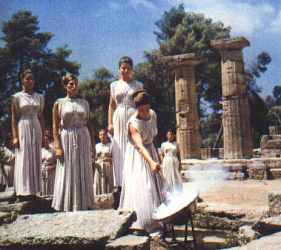
|
|
The Actual Relay
From Olympia to Okinawa On 21st August 1964, H.M., King Constantine II of Greece, together with H.R.H., Princess Irene, as chairman of the Hellenic Olympic Committee, arrived at Olympia. They laid a lourel wreath at the tomb where the heart of Baron Pierre de Coubertin is enshrined. About this same hour, at the ruins of the ancient Temple of Zeus, the Priestesses were igniting the Sacred Olympic Flame in the Bowl from the heat of the rays of the sun. This Olympic Torch in the Bessel, guarded by junior priestesses, was then transferred to the site of the Ancient Olympics, where H.M. the King, H.H. the Princess, President Brundage of the International Olympic Committee, President Yasukawa of the Organizing Committee, Chairman Takashima of the Olympic Torch Relay Dommittee and other officials were waiting. In this impressive ceremony, Chief Priestess, Mrs. Aleca Katselli lit the Torch from the vessel, and handed it to H.M. King Constantine, who in turn handed the Torch to the first relay runner, George Marcellos, the Greek 110-yard hurdle champion. 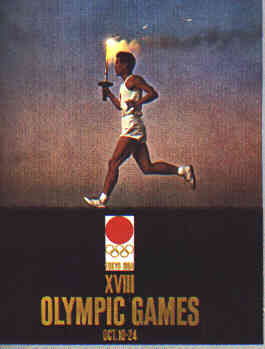
With the torch held high, Marcellos first stopped at the Coubertin Memorial Park, to light the Olympic Flame Cauldron in front of the shrine. He then proceeded to Pyrgos, the first relay point. Thus was started the Olympic Torch on the relay which was to take it all the way to Tokyo in the Far East, to link the two continents of Europe and Asia. The Torch was carried northward along the shores of the Ionian Sea. The sun began to set as the Torch reached Patras, at the mouth of the Gulf of Corinth, but the relay runners pressed onward to Athens through the night under the pale light of the full moon. It was on the following evening that the Torch finally reached the marbleconstructed Pan-Athenian Stadium, the first venue of the Modern Olympics. Here the city of Athens turned out to welcome the Sacred Fire. 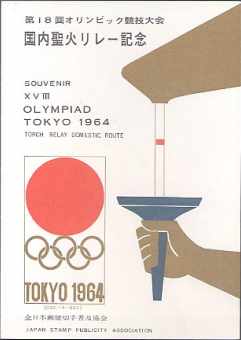
After the second fire had been set aflame on the mounted cauldron especially set up at the stadium, and amidst the impressive ceremonies of benediction, the relay started again, this time to the Hellinikon Airport. It was here that the Sacred Torch was taken into Japanese custody for the first time, as the Torch was handed over to the President of the Organizing Committee for the XVIII Games, Mr. Yasukawa as representing Japan's Olympic delegation. The Olympic Torch, kept at rest in the Airport precincts overnight, was carried to the special Olympic Torch Relay Plane, "City of Tokyo" on the following day, 23rd August. At 2.15 p.m., the plane took-off for Istanbul, the first stop-over city, and landed at the Yesilkoy Airport in the suburb of Istanbul at 5.00 p.m. that evening. The Olympic Flame thus spent its first night in Asia in Turkey. 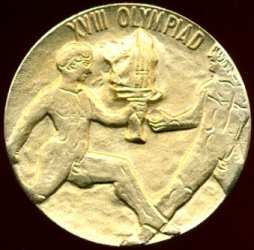
On the 24th the flame was flown to Beirut (Lebanon) and Teheran (Iran); on the 27th to Lahore (Pakistan); the 28th to New Delhi (India) and Rangoon (Burma); the 31st it was in Bangkok (Thailand); 2nd September in Kuala Lumpur (Malaysia) and the 3rd of September in Manila (the Philippines). At each of these air relay stopover cities, the Olympic Torch received a most enthusiastic reception. Up to this time, the extra day each scheduled in reserve had been spent in Beirut and Bangkok. At New Delhi, the Torch was apportioned in order to present a flame of the Sacred Fire to the representatives of Nepal who by previous arrangement had been given permission to use it in a relay ceremony at Katmandu. |
| Country | Date | Distance | Runners | Torches |
|---|---|---|---|---|
| Greece | 21.08. - 23.08.1964 | 366 | ||
| With Aeroplane "City of Tokyo" Stop in: |
23.08. - 07.09.1964 | - | ||
|
Turkey Lebanon Iran Pakistan India Burma Thailand Malaysia Philippines Hongkong Taiwan |
23.08.1964 24.08.1964 26.08.1964 27.08.1964 28.08. - 30.08.1964 30.08.1964 31.08.1964 02.09.1964 03.09.1964 04.09.1964 06.09.1964 |
Total distance 15,508 km |
- | |
| Japan | 07.09. - 10.10.1964 | 6,755 km | - | |
| Total | 7,487 km | 100,603 |
More details once will find in the Official Report, vol. 1, page 245
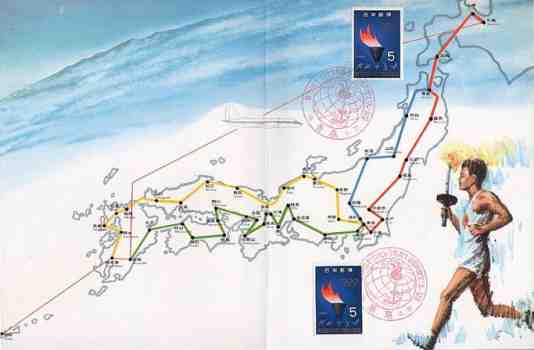
Cities visited between Olympia and Okinawa
1. Athens (Greece)
2. Istanbul (Turkey)
3. Beirut (Lebanon)
4. Teheran (Iran)
5. Lahore (Pakistan)
6. New Delhi (India)
7. Rangoon (Burma)
8. Bangkok (Thailand)
9. Kuala Lummpur (Malaisia)
10. Manila (Philippines)
11. Hong Kong (Hong Kong)
12. Taipe (Republik of China)
This apportioned Torch was then air-relayed back to Calcutta to rejoin the main Torch. Thus was fulfilled the wish of Nepal, a new Asian members of the International Olympic Committee. The special relay plane reached the Kaitak Airport of Hong Kong on 4th September, despite intermittent heavy rain due to an approaching typhoon. The Olympic Torch was handed under the cover of an umbrella to Mr. A. de O. Sales, chairman of the Hong Kong Olympic Committee, and from him to the relay runner. The Torch, relayed through the streets of Kowloon was then ferried from the Kowloon wharf to the island of Hong Kong on the Governor-General's private launch, and the Sacred Flame burned throughout the night at the City Hall. At midnight on the fourth, Hong Kong was struck
by a Typhoon, and the special plane moored at the airport suffered a damaged
wing, which rendered it impossible to be used for flying This incident
necessitated the first alteration in the detailed Torch Relay schedule.
Japan Air Lines to meet this emergency, rushed a Convair 88DM jet plane
from Haneda to Hong Kong, and this enabled the relay flying from the Kaitak
Airport only one day behind the schedule. Unfortunately however this substitute
plane itself developed engine trouble just after the take-off and the flight
was again delayed. To prevent further delay, another plane was made available
by switching over a plane of the same type which was in Hong Kong on a
regular scheduled flight. This emergency measure made possible the take-off
on the same day, and enabled the plane to reach Taipei at 5.00 p.m. that
same evening and just one day behind schedule. Tens of thousands were at
the Taipei International Airport to welcome the Sacred Torch carrier. (Source document: Official report 1964, vol. I, page 245 - 268) |